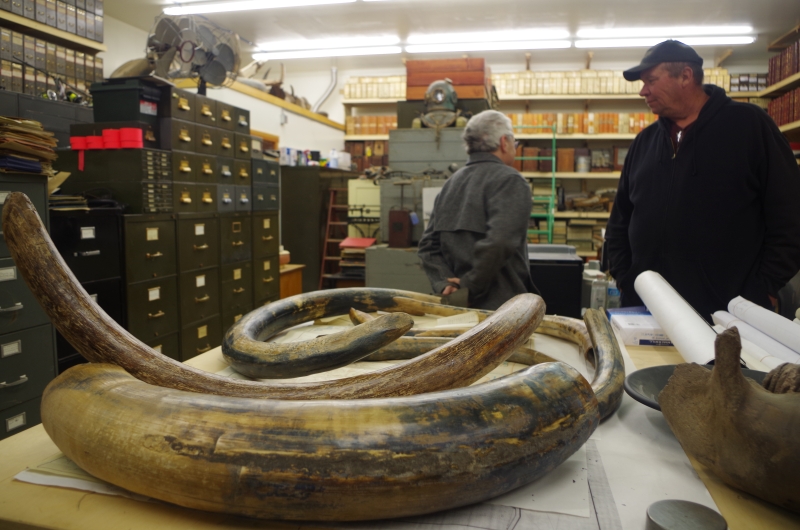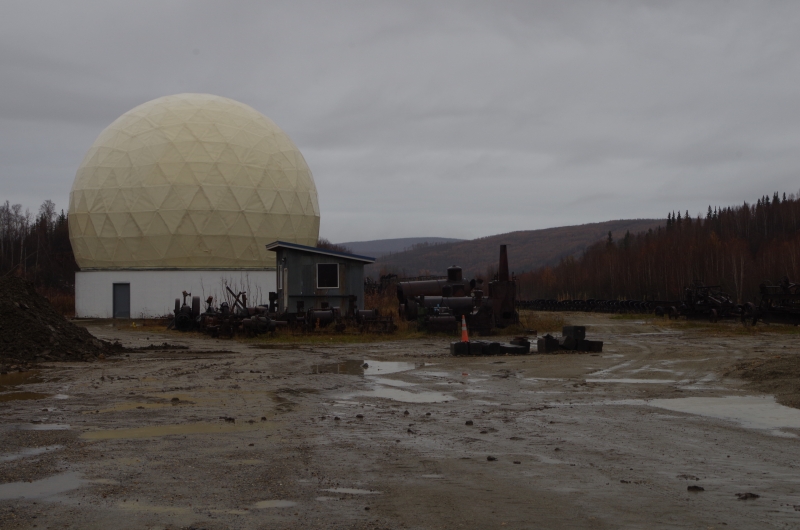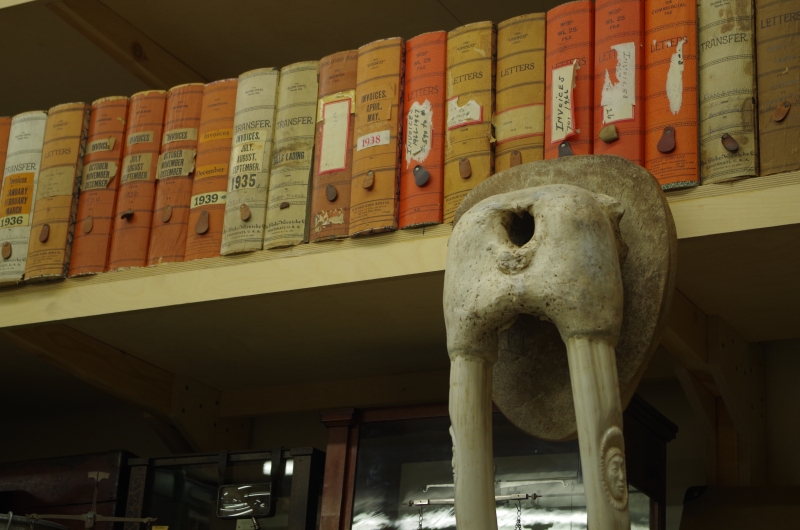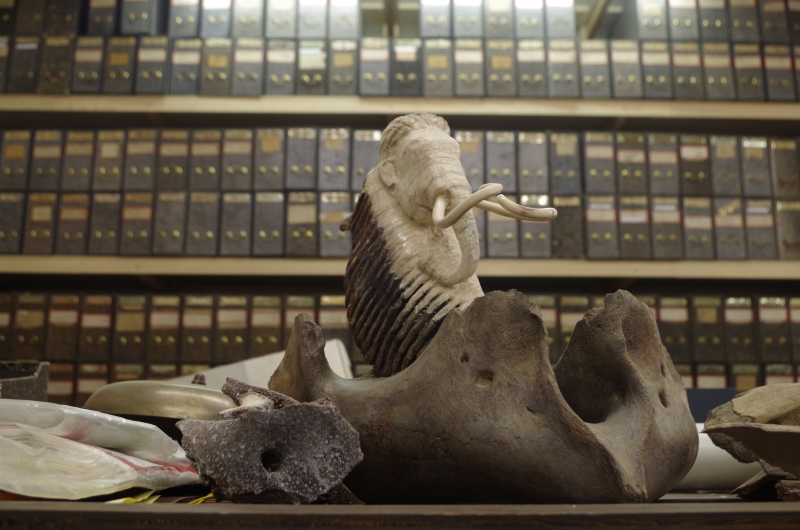
“It tastes like shoe leather. It’s good with ketchup, too.”
That’s how John Reeves, a larger-than-life character in Alaska, described the taste of barbecued mammoth. In a land of big mountains and ever bigger dreams, the former champion swimmer still cuts an imposing profile. He stands 6 feet 10 inches tall but proudly reminds us that his son surpasses seven feet. Reeves is also one of the largest private landowners in Alaska. His company, Fairbanks Gold, LLC, owns thousands of acres of patented mining grounds and also holds numerous additional claims along rivers in both state and federal land.
With all of his land, Reeves is constantly uncovering mammoth tusks and bones. They aren’t hard to find in this part of the world, which, along with Siberia, formed the stomping grounds of the woolly mammoth. Not infrequently, the beasts’ remains have several-thousand-year-old meat still attached when unearthed. Permafrost in Alaska and Siberia creates cryogenic-like conditions that are near perfect for storing a mammoth for eons. Some people might think of sending the ancient mammoth carcass to a lab for studies, but John Reeves isn’t that kind of guy. Instead, he tossed it on the grill.
The impractical meet the entrepreneur


At the last minute, our research network – a mix of decidedly academic professors and students with the PhD Seminar in Arctic Extractive Industries that was taking place at the University of Alaska, Fairbanks – arranged to visit Reeves on one of his many plots of land last week. Our organizer, Alaskan historian Terrence Cole, joked that we would be the type of people Reeves would call “impractical.” Yet the big and tall landowner greeted us in that warm but no-nonsense kind of manner that seems typical of Alaskans.
We met Reeves on his property just off the Steese Highway leading north out of Fairbanks. Across the motorway, the silvery Trans-Alaska Pipeline was visible through the orange birch trees. The smell of roasting coffee filled the air, which was inexplicable until Reeves explained to us that his wife was into roasting coffee beans from Costa Rica. He bemusedly complained that due to the expense of roasting, they weren’t able to draw a profit from it.
Earning money and keeping it is a lesson that Reeves, a lifelong entrepreneur, has taught to his children since they were young. He regaled us with a story about family dinnertime. “The kids would have french fries on their dinner plates, and if they didn’t say ‘No Taxation Without Representation’ in time, I’d grab one of them,” he laughed. “They learned real quick.” It’s this sort of attitude that has allowed Reeves to prosper in a state known for its get-rich-or-die-trying view on life.
Like many self-made Alaskans, John Reeves hitchhiked up here after deciding that life in the Lower 48 – specifically college in Florida – wasn’t for him. But he didn’t throw in the towel once he made it to the Last Frontier. Instead, back in the 80s, he bought a former gold dredging site outside Fairbanks and developed it into a tourist attraction where visitors could pan for gold and keep what they find. He later sold it to the cruise company Holland America. The site has since become the subject of a court case – something else Reeves is famous for, as journalist Dermot Cole (coincidentally Terrence Cole’s brother) has reported.
A taste for mammoths – and history
At first, it seemed like money is what makes Reeves spin. But after spending about an hour with Reeves, it became clear that the forces driving him are bigger than cash. They are history, gold, and mammoths – some of the legends that Alaska itself is built on.
Reeves didn’t spend too much time talking about how he had come to be one of the largest landowners in Alaska, after the federal government and the Native regional corporations. Instead, he appeared more interested in showing us the artefacts of his adopted state’s history, from the Pleistocene to the present.
On top of the snow-soaked mud sat hundreds of pieces of equipment collected from Fairbanks’ Gold Rush days in the 1900s, when entire valleys were dredged and filled with water. At the back of the property sat a disused “overland train” – specifically, a Model-VC 22 Sno-Freighter. The American construction company LeTourneau Technologies developed this mode of transportation in the 1950s for moving across Arctic tundras without a need for roads, and sold it to the U.S. Army for use in constructing the Distant Early Warning Line in the early days of the Cold War. Originally, each of the 24 tires had an electric motor – that is, until copper thieves came around to Reeves’ property and stripped them.

Sheltered from the cold, one building on Reeves’ property was full of books and documents about mining, which he had obtained by purchasing the entire contents of a library in Utah. In this same room were all sorts of other incredible relics: scrimshaw (carvings or paintings on whale bone, walrus tusks, and other types of ivory), fox furs, and hundreds of maps that might hold the secrets to a new gold find. It would be possible to fill an entire small museum with his collections. There was even an early 20th-century diving suit hanging on the wall. It had been used by a technician to swim underwater and look for gold after a valley had been dredged and submerged.
Reeves has his eye on the future, too, however. As he held enormous gold nuggets in his hands, he expressed his certainty that there’s still plenty of gold to be found in Alaska and described how the search had progressed to the next level. Prospectors are now looking for “nanogold,” ultrafine gold that is left over in the tailings and detritus left behind by previous efforts.



Straight talk on Fairbanks and mammoths
In one of many typically unscripted moments while we were walking around Reeves’ property, he shared his thoughts with us completely unfiltered. His candor was refreshing after we had spent two days in a conference where everyone from oil executives to government representatives took great pains to be politically correct.
“I think of Fairbanks as a political animal,” Reeves offered. “Ester is where the hippies are. The center is the middle of the road. And the North Pole is full of meth heads, but they go to church on Sunday.” (True to form, in Ester, west of downtown Fairbanks, we had gone to a bar for the Arctic Energy Summit’s opening reception where we chatted with a liberal filmmaker from Whitehorse as the Smiths were jingling on the stereo and Major League Soccer played on TV.) If Reeves’ entrepreneurial spirit had turned him into a landowner, his frankness had turned him into a TV star: he and his family were once stars on the National Geography reality TV show called “Goldfathers.”

Despite Reeves’ multiple careers as champion swimmer, landowner, historic preservationist, and state employee, the outsized Alaskan appears more of a modern-day mammoth hunter than anything. In yet another building – one entirely dedicated to mammoth specimens – he showed us his collection of tusks, bones, and two whole skeletons – all found on a parcel of land half the size of the parking lot to his place. This collection seemed to be his pride and joy and something he’s not keen to exchange for cash anytime soon – even though, according to Reeves, a pair of mammoth tusks can fetch up to $485,000 on eBay. Knowing this price, his wife had suggested that he sell a couple on eBay, Reeves explained to us while chuckling. “But why would I do that? Mammoth tusks are more fun to look at. I like them more than the stacks of $100 bills.” Money isn’t everything.




4 Comments
The man with the mammoth bones